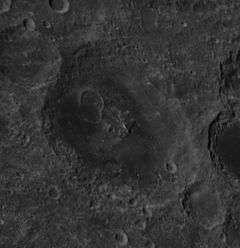Joliot (crater)
Joliot is a large lunar impact crater that lies on the far side of the Moon, just past the eastern limb. At this location it lies in a region of the surface that comes into sight during a favorable libration, although at such times it is viewed from the side. Thus viewing this crater in detail must be done from orbit.
 Oblique Apollo 16 Panoramic camera image | |
| Coordinates | 25.8°N 93.1°E |
|---|---|
| Diameter | 164 km |
| Depth | Unknown |
| Colongitude | 269° at sunrise |
| Eponym | Frédéric Joliot-Curie |

The crater lies at the northern fringes of the lava-flooded region of the surface associated with Mare Marginis to the south. The crater Lomonosov is located just to the east-northeast, and Lyapunov is attached to the western rim. Also attached to the northwest rim, and thus adjacent to Lyapunov, is the crater Rayleigh. Southwest of Joliet is Hubble and farther to the south lies Al-Biruni.
The outer rim of Joliet is worn and somewhat disintegrated, particularly in the northern and southern sections where the outer wall consists of little more than irregular ridges and craterlets. The rim is somewhat more intact to the east, and particularly so in the west where it has been buttressed by adjacent crater formations.
Within the outer rim, the interior floor has been flooded in the past by basaltic lava, leaving a relatively flattened surface that has a lower albedo than the surrounding terrain and so appears darker. Parts of the floor have been coated in ray material from the fresh crater Giordano Bruno to the northeast.
The lava-covered floor contains several ghost-crater remnants, with the largest being an elongated formation to the west of the midpoint. At the midpoint of the floor is a central peak formation.
Satellite craters
By convention these features are identified on lunar maps by placing the letter on the side of the crater midpoint that is closest to Joliot.
| Joliot | Latitude | Longitude | Diameter |
|---|---|---|---|
| P | 22.2° N | 91.9° E | 12 km |
References
- Andersson, L. E.; Whitaker, E. A. (1982). NASA Catalogue of Lunar Nomenclature. NASA RP-1097.CS1 maint: ref=harv (link)
- Blue, Jennifer (July 25, 2007). "Gazetteer of Planetary Nomenclature". USGS. Retrieved 2007-08-05.CS1 maint: ref=harv (link)
- Bussey, B.; Spudis, P. (2004). The Clementine Atlas of the Moon. New York: Cambridge University Press. ISBN 978-0-521-81528-4.CS1 maint: ref=harv (link)
- Cocks, Elijah E.; Cocks, Josiah C. (1995). Who's Who on the Moon: A Biographical Dictionary of Lunar Nomenclature. Tudor Publishers. ISBN 978-0-936389-27-1.CS1 maint: ref=harv (link)
- McDowell, Jonathan (July 15, 2007). "Lunar Nomenclature". Jonathan's Space Report. Retrieved 2007-10-24.CS1 maint: ref=harv (link)
- Menzel, D. H.; Minnaert, M.; Levin, B.; Dollfus, A.; Bell, B. (1971). "Report on Lunar Nomenclature by the Working Group of Commission 17 of the IAU". Space Science Reviews. 12 (2): 136–186. Bibcode:1971SSRv...12..136M. doi:10.1007/BF00171763.CS1 maint: ref=harv (link)
- Moore, Patrick (2001). On the Moon. Sterling Publishing Co. ISBN 978-0-304-35469-6.CS1 maint: ref=harv (link)
- Price, Fred W. (1988). The Moon Observer's Handbook. Cambridge University Press. ISBN 978-0-521-33500-3.CS1 maint: ref=harv (link)
- Rükl, Antonín (1990). Atlas of the Moon. Kalmbach Books. ISBN 978-0-913135-17-4.CS1 maint: ref=harv (link)
- Webb, Rev. T. W. (1962). Celestial Objects for Common Telescopes (6th revised ed.). Dover. ISBN 978-0-486-20917-3.CS1 maint: ref=harv (link)
- Whitaker, Ewen A. (1999). Mapping and Naming the Moon. Cambridge University Press. ISBN 978-0-521-62248-6.CS1 maint: ref=harv (link)
- Wlasuk, Peter T. (2000). Observing the Moon. Springer. ISBN 978-1-85233-193-1.CS1 maint: ref=harv (link)